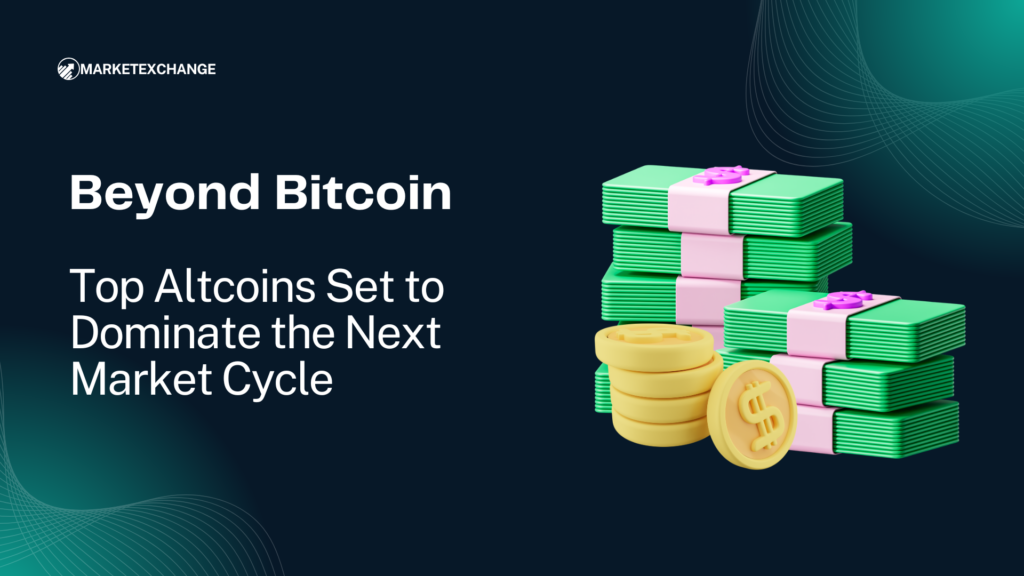Beyond Bitcoin: Top Altcoins Set to Dominate the Next Market Cycle
Introduction: The Shift Beyond Bitcoin
Bitcoin remains the dominant cryptocurrency, but altcoins are rapidly gaining traction. With evolving blockchain technology, increasing institutional adoption, and the expansion of decentralized finance (DeFi), several altcoins are positioned to play a major role in the next market cycle.
As the crypto landscape matures, investors are looking beyond Bitcoin for the next high-growth digital assets. This article explores the top altcoins that could potentially outperform Bitcoin in the coming years.
1. Ethereum (ETH) – The Leading Smart Contract Platform
Why Ethereum Remains a Strong Contender
Ethereum continues to be the backbone of smart contracts, decentralized finance (DeFi), and non-fungible tokens (NFTs). The transition to proof-of-stake through the Ethereum Merge and subsequent upgrades have enhanced its scalability and energy efficiency.
Key Advantages:
- The most widely used blockchain for DeFi, NFTs, and decentralized applications
- Strong institutional adoption and developer ecosystem
- Upcoming layer-2 scaling solutions such as Optimism and Arbitrum
Potential Risks:
- High transaction fees remain a challenge
- Increasing competition from other layer-1 blockchains
2. Solana (SOL) – The High-Speed Ethereum Alternative
Solana has gained attention for its ability to process transactions faster and at lower costs than Ethereum. With its proof-of-history consensus mechanism, it can handle over 65,000 transactions per second, making it an attractive choice for DeFi and NFT projects.
Key Advantages:
- Ultra-fast transactions with minimal fees
- Strong presence in gaming, NFTs, and DeFi
- Growing developer ecosystem despite past network stability concerns
Potential Risks:
- Occasional network outages and reliability issues
- Dependence on venture capital funding
3. Polygon (MATIC) – Ethereum’s Scaling Solution
Polygon serves as a layer-2 scaling solution for Ethereum, providing faster and cheaper transactions. With growing partnerships across major corporations such as Meta, Starbucks, and Reddit, it is facilitating mainstream Web3 adoption.
Key Advantages:
- Improves Ethereum’s scalability and interoperability
- Strategic partnerships with global enterprises
- Expansion into zero-knowledge rollups for enhanced efficiency
Potential Risks:
- Competition from other layer-2 solutions such as Arbitrum and Optimism
- Reliance on Ethereum’s continued growth
4. Cardano (ADA) – The Research-Driven Blockchain
Cardano takes a scientific approach to blockchain development, focusing on security, scalability, and sustainability. With the implementation of smart contracts, it has expanded its DeFi and NFT capabilities.
Key Advantages:
- Focus on peer-reviewed research and long-term development
- Scalability improvements with ongoing updates
- Expanding adoption in developing countries
Potential Risks:
- Slower adoption compared to competitors
- Lower total value locked (TVL) in DeFi
5. Avalanche (AVAX) – A Multi-Chain Scaling Solution
Avalanche is designed for high-speed blockchain transactions with near-instant finality. Its multi-chain framework enables projects to create their own customized blockchain solutions.
Key Advantages:
- High scalability through subnet architecture
- Strong use cases in DeFi and enterprise applications
- Compatibility with Ethereum’s Virtual Machine (EVM)
Potential Risks:
- Intense competition from Ethereum and Solana
- Network congestion during peak periods
6. Chainlink (LINK) – The Leading Oracle Network
Chainlink is the dominant decentralized oracle network, providing real-world data to blockchain applications. It plays a crucial role in DeFi, gaming, and automation within smart contracts.
Key Advantages:
- Essential infrastructure for price feeds and DeFi applications
- Strong partnerships with top blockchain projects
- Expansion into staking and hybrid smart contracts
Potential Risks:
- Dependence on Ethereum’s ecosystem
- Competition from emerging oracle solutions
7. Cosmos (ATOM) – The Blockchain Interoperability Solution
Cosmos aims to connect multiple blockchains through its Inter-Blockchain Communication (IBC) protocol. This allows different blockchains to interact seamlessly, solving one of the biggest challenges in the industry.
Key Advantages:
- Focus on interoperability and cross-chain communication
- Expanding ecosystem of independent blockchains
- Attractive staking rewards and governance features
Potential Risks:
- Competition from other cross-chain solutions such as Polkadot
- Growth dependent on adoption of its IBC protocol
8. Polkadot (DOT) – A Cross-Chain Innovation Leader
Polkadot is designed for interoperability by enabling multiple blockchains to communicate through parachains. It offers scalability and security while allowing projects to operate independently.
Key Advantages:
- Advanced scalability through parachain architecture
- Strong emphasis on interoperability and decentralized governance
- Growing developer activity and ecosystem expansion
Potential Risks:
- Complex governance model
- Competition from Cosmos and other interoperability-focused projects
9. Near Protocol (NEAR) – A Developer-Friendly Blockchain
Near Protocol simplifies blockchain development with user-friendly tools and scalability through sharding. It has been expanding its presence in Web3 applications, gaming, and DeFi.
Key Advantages:
- High-speed transactions with low costs
- Developer-friendly ecosystem for smart contract deployment
- Growth in Web3 and Metaverse applications
Potential Risks:
- Limited mainstream recognition compared to other blockchains
- Ecosystem growth still in early stages
10. XRP (XRP) – A Leader in Cross-Border Payments
XRP continues to be a dominant force in cross-border transactions, despite regulatory challenges. Its partnerships with financial institutions make it a strong contender for mainstream payment solutions.
Key Advantages:
- Fast and cost-effective international transactions
- Strong backing from institutional players
- Resilient ecosystem despite ongoing legal scrutiny
Potential Risks:
- Uncertainty due to legal battles with regulatory authorities
- Increasing competition from central bank digital currencies (CBDCs)
Conclusion: The Future of Altcoins in the Next Market Cycle
The next crypto market cycle will likely see increased adoption and innovation among altcoins. While Bitcoin continues to lead the market, these altcoins are positioned to capture significant growth due to their unique use cases and expanding ecosystems.
For investors, diversification into high-potential altcoins may present opportunities for higher returns. However, thorough research and risk assessment remain essential before investing in any digital asset.
